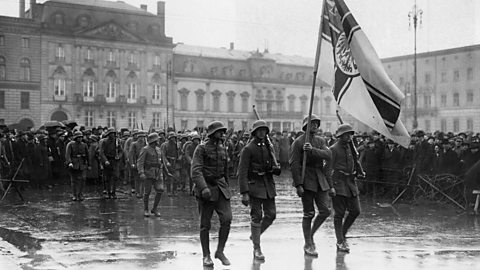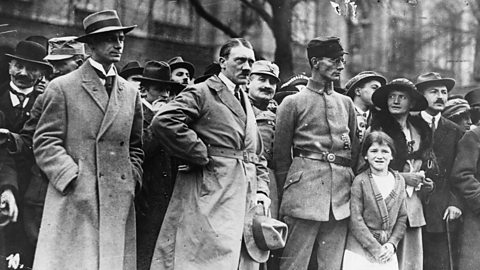The establishment of the Weimar Republic
In November 1918 Germany surrendered and World War One was lost. A revolution followed in which Germany became a republicA country where the leader is elected or nominated by the people. and a democracyA type of government where people govern themselves or elect representatives to govern for them.. This timeline sets out the major events in the new republicās early life, up to the beginning of 1925:
1918:
- 9 November ā the ruling monarch, Kaiser Wilhelm II, abdicateTo give up a claim (often a claim to a monarchy). and Germany became a republic.
- 11 November ā World War One ended when an armisticeAn end to the fighting in a war. was agreed with the Allies (Britain, France and the USA) and Germany surrendered.

The Spartacist uprising in Berlin - demonstration of armed spartacists in the Jerusalemer StraĆe
1919:
- 5-12 January ā the Spartacist Uprising occurred when 50,000 members of the German Communist Party, known as the SpartacistsThe name given to the communist party in post-World War One Germany., rebelled in Berlin, led by Rosa Luxemburg and Karl Liebknecht.
- Late January ā a group of members elected to represent the German people, a National Assembly, met to draw up a new constitution (a set of rules and laws) for Germany.
- 28 June ā the new German government was forced to sign a peace settlement called the Treaty of VersaillesThe peace treaty signed by the Allies and Germany at the end of the First World War, on 28 June 1919..
- 31 July ā a new constitution was agreed by the National Assembly and Ebert was appointed Germanyās first President.

Putschists marching with the Imperial War flag at Pariser Platz Square
1920:
- 13-17 March ā the right-wing nationalistOne who promotes the independence of their own nation from others. Dr Wolfgang Kapp led an attempted putschGerman word meaning an attempt to overthrow the government (the Kapp Putsch) in Berlin. The government was only saved when the workers of Berlin went on strike.
- June - the first elections in what became known as the Weimar Republic took place.

Adolf Hitler, Alfred Rosenberg (left) and Dr Friedrich Weber of the Freikorps Oberland, during the Munich Putsch
1921:
- May ā the amount of reparationMonetary compensation from an individual, group or state to compensate victims. Germany had to pay was set at Ā£6.6 billion.
1922:
- November ā Germany defaulted on its reparations payment as scheduled. The first reparations payment had taken all she could afford to pay. The French believed Germany could make the repayment but were choosing not to, however the German government argued they could not afford to pay.
1923:
- January ā in response, France and Belgium sent troops into Germanyās main industrial area, the RuhrThe main industrial area of Germany. Valley. Their aim was to confiscate industrial goods as reparations payments. The German response ā passive resistanceTo resist something by not cooperating, or refusing to follow instructions without using violence. ā led to hyperinflationVery rapid and high increase in the level of prices, combined with a fall in the value of money..
- August ā with bank notes costing more to print than they were worth, Chancellor Stresemann introduced a new currency called the Rentenmark. This ended the hyperinflation crisis.
- 8 November ā The fledgling Nazi Party attempted to gain power in the Munich Putsch.
1924:
- August ā The Dawes Plan, rescheduling Germanyās reparations payments, was agreed.
Excerpt from the Treaty of Versailles, 1919